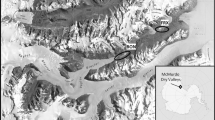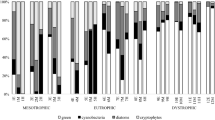Abstract
Bacterioplankton from 10 oligotrophic lakes, representing a gradient from clearwater to polyhumic, were grown in dilution cultures of sterile filtered lake water. The bacterial biomass achieved in the stationary phase of the dilution cultures was positively correlated with the amount of both humic matter and dissolved organic carbon (DOC) in the lakes. About the same fraction of the total DOC pool was consumed in the dilution cultures of all lakes (average 9.5%, coefficient of variation (CV) 24%), with approximately the same growth efficiency (average 26%, CV 28%). Thus, humic lakes could support a higher bacterial biomass than clearwater lakes due to their larger DOC pools. The relevance of the results to planktonic food webs of humic and clearwater lakes is discussed.
Similar content being viewed by others
References
Ammerman JW, Fuhrman JA, Hagström Å, Azam F (1984) Bacterial growth in seawater. 1. Growth kinetics and cellular characteristics in seawater cultures. Mar Ecol Prog Ser 18:31–39
Andersson A, Larsson U, Hagström Å (1986) Size-selective grazing by a microflagellate on pelagic bacteria. Mar Ecol Prog Ser 33:51–77
Bailey NTJ (1981) Statistical methods in biology, 2nd ed. Hodder and Stoughton, London
Bell RT, Kuparinen J (1984) Assessing phytoplankton and bacterioplankton production during early spring in Lake Erken, Sweden. Appl Environ Microbiol 45:1709–1721
Bergström I, Heinänen A, Salonen K (1986) Comparison of acridine orange, acriflavine, and bisbenzimide stains for enumeration of bacteria in clear and humic waters. Appl Environ Microbiol 51:664–667
Björnsen PK (1986) Automatic determination of bacterioplankton biomass by means of image analysis. Appl Environ Microbiol 51:1199–1204
Björnsen PK (1986) Bacterioplankton growth yield in continuous seawater cultures. Mar Ecol Prog Ser 30:191–196
Bratbak G (1985) Bacterial biovolume and biomass estimations. Appl Environ Microbiol 49:1488–1493
Cynar FJ, Estep KW, Sieburth JM (1985) The detection of bacteria-sized protists in “protist-free” filtrates and their potential impact on experimental marine ecology. Microb Ecol 11:281–288
Ducklow HW, Purdie DA, Williams PJL, Davis JM (1986) Bacterioplankton: a sink for carbon in a coastal marine plankton community. Science 232:865–867
Fenchel T (1982) Ecology of heterotrophic microflagellates. I. Some important forms and their functional morphology. Mar Ecol Prog Ser 8:211–223
Fenchel T, Blackburn TH (1979) Bacteria and mineral cycling. Academic Press, London
Fuhrman JA, Bell TM (1985) Biological considerations in the measurement of dissolved free amino acids in seawater and implications for chemical and microbiological studies. Mar Ecol Prog Ser 25:13–21
Fuhrman JA, McManus GB (1984) Do bacteria-sized marine eucaryotes consume significant bacterial production? Science 224:1257–1260
Geller A (1986) Comparison of mechanisms enhancing biodegradability of refractory lake water constituents. Limnol Oceanogr 31:755–764
Goldman JC, McCarthy JJ, Peavy DG (1979) Growth rate influence on the chemical composition of phytoplankton in oceanic waters. Nature 279:210–215
de Haan H (1972) On the determination of soluble humic substances in fresh waters. Proc Int Meet Humic Substances 26–53
de Haan H (1974) Effect of a fulvic acid fraction on the growth of aPseudomonas from Tjeukemeer (the Netherlands). Freshwat Biol 4:301–310
Heldal M, Norland S, Tumyr O (1985) X-ray microanalytical method for measurement of dry matter and elemental content of individual bacteria. Appl Environ Microbiol 50:1251–1257
Hessen DO (1985) The relation between bacterial carbon and dissolved humic compounds in oligotrophic lakes. FEMS Microbiol Ecol 31:215–223
Hobbie JE, Williams PJL (ed) (1984) Heterotrophic activity in the sea. Plenum Press, New York
Höfle MG (1984) Can mixed cultures help the understanding of natural heterotrophic processes? Arch Hydrobiol Beih 19:53–58
Hutchinson GE (1967) A treatise on limnology, vol. II. John Wiley & Sons, New York
Johansson JÅ (1983) Seasonal development of bacterioplankton in two forest lakes in central Sweden. Hydrobiol 101:71–87
Meyer JL, Edwards RT, Risley R (1987) Bacterial growth on dissolved organic carbon from a blackwater river. Microb Ecol 13:13–29
Murphy J, Riley JP (1962) A modified single solution method for the determination of phosphate in natural waters. Anal Chem Acta 27:31–36
Norland S, Heldal M, Tumyr O (1987) On the relation between dry matter and volume of bacteria. Microb Ecol 13:95–101
Poindexter JS (1981) The caulobacters: ubiquitous unusual bacteria. Microbiol Rev 45:123–179
Porter KG, Feig YS (1980) The use of DAPI for identifying and counting aquatic microflora. Limnol Oceanogr 25:943–948
Salonen K, Kolonen K, Arvola L (1983) Respiration of plankton in two small, polyhumic lakes. Hydrobiol 101:65–70
Sederholm H, Mauranen A, Montonen L (1973) Some observations on the microbial degradation of humous substances in water. Verh Internat Verein Limnol 18:1301–1305
Seppänen H (1971) Bacteriological studies on waters with a low electrolyte concentration. Helsinki University of Technology Research Papers 34
Sieburth JM (1984) Protozoan bacterivory in pelagic marine waters. In: Hobbie JE, Williams PJL (eds) Heterotrophic activity in the sea. Plenum Press, New York
Sieracki ME, Johnson PW, Sieburth JM (1985) Detection, enumeration, and sizing of planktonic bacteria by image-analyzed epifluorescence microscopy. Appl Environ Microbiol 49:799–810
Sieracki ME, Sieburth JM (1985) Factors controlling the periodic fluctuation in total planktonic bacterial populations in the upper ocean: comparison of nutrient, sunlight and predation effects. Marine Microbial Food Webs 1:35–50
Stanier RY, Adelberg EA, Ingraham JL (1977) General microbiology, 4th ed. The Macmillan Press Ltd, London
Thienemann A (1925) Die binnengewässer Mitteleuropas. Binnengewässer 1.
Tranvik LJ, Höfle MG (1987) Bacterial growth in mixed cultures on dissolved organic carbon from humic and clear waters. Appl Environ Microbiol 53:482–488
Watson SW, Novitsky TJ, Quinby HL, Valois FW (1977) Determination of bacterial number and biomass in the marine environment. Appl Environ Microbiol 33:940–946
Wetzel RG (1983) Limnology, 2nd ed. WB Saunders, Philadelphia
Williams PJL (1981) Incorporation of microheterotrophic processes into the classical paradigm of the planktonic food web. Kieler Meeresforsch Sondh 5:1–28
Williams PJL (1984) Bacterial production in the marine food chain: the emperors new suit of clothes? In: Fasham MJR (ed) Flows of energy and material in marine ecosystems: theory and practice. Plenum Press, New York, pp 271–299
Author information
Authors and Affiliations
Rights and permissions
About this article
Cite this article
Tranvik, L.J. Availability of dissolved organic carbon for planktonic bacteria in oligotrophic lakes of differing humic content. Microb Ecol 16, 311–322 (1988). https://doi.org/10.1007/BF02011702
Issue Date:
DOI: https://doi.org/10.1007/BF02011702




